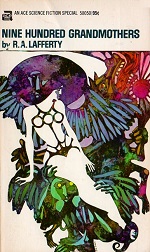|  
 
 
 
 | | | |  The story also appeared in this 1970 collection. The story also appeared in this 1970 collection. | | “The Hole on the Corner”
by R.A. Lafferty
First publication: Orbit 2, Jun 1967

When Homer Hoose arrives home to his perfect home one evening, he is met by other Homers whom the Diogenes Pontifex insists are not Jung’s alternate versions of ourselves, but instead are actual versions of ourselves occupying the same space. None of which has to do with time travel, but the brilliant Diogenes does mention in passing his experiments in other fields. I suppose that’s another Lafferty story, but I haven’t run into it yet. “You speak of it as if . . . well, isn’t this the twentieth century?” Regina asked. “You speak of it as if . . . well, isn’t this the twentieth century?” Regina asked.
 “This the twentieth? Why, you’re right! I guess it is,” Diogenes agreed. “You see, I carry on experiments in other fields also, and sometimes get my times mixed.” “This the twentieth? Why, you’re right! I guess it is,” Diogenes agreed. “You see, I carry on experiments in other fields also, and sometimes get my times mixed.” 
| |
| | | | |

 
 
 
 
 | | | | ![[credit: Don Ivan Punchatz]](covers/anth/an00240-1969-100dpi.jpg) Aldiss’s story was one of eight that were selected for the first (1969) of three separate paperback volumes that together comprised the original anthology. Aldiss’s story was one of eight that were selected for the first (1969) of three separate paperback volumes that together comprised the original anthology.

| | “The Night That All Time Broke Out”
by Brian Aldiss
First publication: Dangerous Visions, Oct 1967

Aldiss confessed that this story contains one of the whackiest ideas that he ever had. Does it contain time travel? You should read the story first and decide for yourself, but here’s my spoil-laden take on the matter:

An invisible, subterranean gas can be supplied right to your house along with controls that let you control its delivery to your brain. Depending on the concentration, the result is to bring aspects of your previous consciousness (or that of your ancestors) right into your present-day brain: physical sensations, bodily abilities, mental attitudes, and the psychological make-up of the chanelled person all take over your body, although you remain present. To me, this could be ancestral memory—perhaps passed down genetically and triggered by the newly discovered gas—but I’m going to list it as time travel. Fifi could not understand what on earth he was talking about. Every since leaving Plymouth, she had been adrift, and that not entirely metaphorically. It was bad enough playing Pilgrim Mother to one of the Pilgrim Fathers, but she did not dig this New World at all. It was now beyond her comprehension to understand that the vast resources of modern technology were fouling up the whole time schedule of a planet. Fifi could not understand what on earth he was talking about. Every since leaving Plymouth, she had been adrift, and that not entirely metaphorically. It was bad enough playing Pilgrim Mother to one of the Pilgrim Fathers, but she did not dig this New World at all. It was now beyond her comprehension to understand that the vast resources of modern technology were fouling up the whole time schedule of a planet. 
| |
| | | | |

 
 
 
 
No Time Travel. Move along. |
Counter-Clock World by Philip K. Dick, Feb 1967 [odd entropy ]

“The Assassination of John Fitzgerald Kennedy...” by J.G. Ballard, New Worlds, Mar 1967 [despite title, no time travel ]

The Jewels of Elsewhen by Ted White, Apr 1967 [despite title, no time travel ]

“To Outlive Eternity” by Poul Anderson, Galaxy, Jun 1967 [time dilation ]

“Compound Interest” by Christopher Anvil, Analog, Jul 1967 [despite title, no time travel ]

| |     |